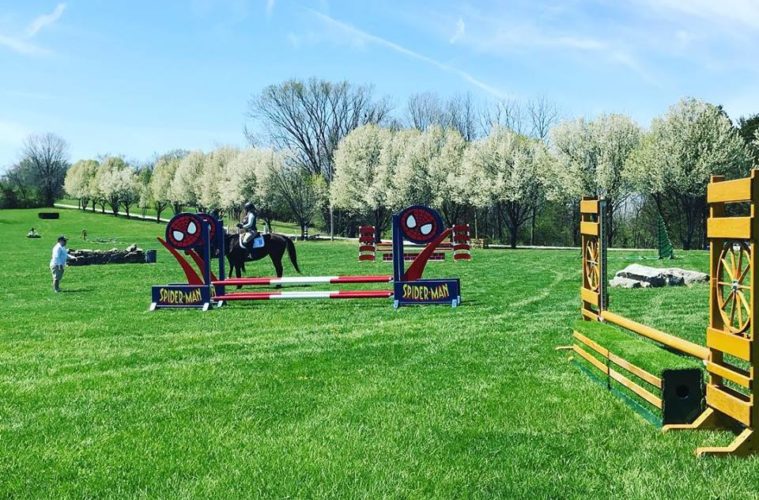Photo by Jen Robertson
Spring is finally here (yes, even up here in the snowbelt — my daffodils are coming up and my horses are finally shedding!). While it’s tempting to throw that saddle on and hit the trails or the show ring, the reality is that for a lot of us, our horses are probably out of shape.
Yes, we have ridden all winter long, but chances are we were relegated to the indoor arena, or if we were lucky, maybe a nice outdoor. I myself was able to hack out in a big snow-covered pasture of cover crop a few days a week. But no matter how many miles we might put in through circles and figures in a flat, winter-safe space, our horses are probably still lacking in true condition: the kind of muscular strength and endurance that comes with long, slow miles out of the arena, traversing the hills.
In this recent run of good weather, I’ve launched my hill work plan to better my horse’s fitness. Here are six ways you can work hills into your springtime conditioning regimen for a fitter equine athlete!
1. Put on your hiking shoes.
Okay, we probably don’t want to admit that we ourselves as riders might be a little out of shape after winter too — so why not accomplish two goals at once? Put on your hiking shoes, put a halter and lead on your horse, and head out to the hills to put conditioning miles on both of you. Start small with short hills and a gradual include before you try scaling mountains.
2. Work hills on the lunge line.
This one is a little easier on you as a handler: lunge your horse in a gentle circle at the walk around you, letting him traverse up and down the hill on a roughly 20′ line. You can move up, down and across the hill as you go, letting your horse navigate varying degrees of slope and flat. As above, start on a gradual slope and work your way up to a steeper incline. Especially for horses lacking muscle tone or green horses who are not used to traveling over hills, this is a great way to let your horse find his own footing and balance without also carrying a rider.
3. Hill work under saddle.
Once your horse is strong enough to carry a rider up and down hills, you can saddle up and head out! If you sensed a “walk before you run” pattern developing, you’re absolutely right: walk hills, starting with a gradual slope and short distance, before tackling bigger hills or moving to the trot or canter.
Ascending hills under saddle builds strength in the horse’s front and hind legs as well as builds muscling over the top line — the neck and back muscles of the horse. Ideally, a horse should ascend a hill by lowering his head and reaching under himself with his hind legs; if you’ve done your homework with a green horse working hills from the ground he should develop this form naturally. If your horse wants to rush up the hill by pulling himself along on his forehand, correct him and ask him to walk.
Backing up and down hills is also a great strengthening exercise.
4. Descend via switchback.
One of the particular reasons I employ hill work is to strengthen my horse’s identified weak stifles — ascending hills can help strengthen that joint, but descending hills is counterproductive and places too much strain on that area. Generally speaking, while a horse should be able to safely navigate a downhill slope, especially as a trail mount, descending a hill on a switchback (a zig-zag pattern that allows the horse to descend gradually) is more comfortable and reduces the load on joints and soft tissue.
If you have the option to create a switchback down a hill, allow the horse to descend at an angle, zig-zagging gently back and forth to come down the hill.
As a visual, here’s a look at one of my recent hill rides via the Huufe app’s ride tracking feature: you can see my direct route up the hill, and my much longer, gradual descent as I switched back down the field.
5. Traverse the sides of hills.
Equally important to traveling up and down slopes, navigating across a slope helps build balance and nimble footwork on horses. Trekking the shoulder of a hill in both directions (putting the right side of the horse on the uphill side, then the left) will improve a horse’s coordination, and better prepare them to tackle uneven footing.
6. Don’t have access to hills?
While hill work in its pure form has many benefits — including getting the horse out of the arena for a mind-refreshing hack and putting him on different footing — you can still gain some of those rewards even if you live in an area that’s flat as a pancake or you don’t have easy or immediate access to any good hills that you can work safely. Working over obstacles such as poles (start flat on the ground, then raise them on one or both sides) can help the horse to use his body in similar ways as he would if he were climbing a hill, though the rider must be sure that they are encouraging correct form and engaging the horse from behind.
Go riding!

